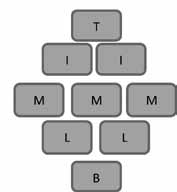By Robyn English
The ultimate aim of all teaching of literature should be to instil in children a love of stories and reading. Sadly, many students will claim that this love has been destroyed by the insistence of teachers that they ‘study’ the book. This activity is a strategy that can be used to generate and structure discussion so that a good book can be discussed without over-analysing it.
Diamond ranking
The purpose of this activity is to generate discussion about priorities. Different text types will have different things to prioritise. For the purposes of this discussion, these things are referred to as ‘elements’. Diamond ranking is a good strategy to use with texts that consider opinions and encourages students to justify their beliefs and feelings. After reading, The Last King of Angkor Wat, by Graeme Base, the class could identify nine characteristics of a successful leader. After reading, The Duck and the Darklings, by Glenda Millard, the group might list nine reasons for Peterboy to keep Idaduck. If studying a longer novel, the class might identify nine events from  the story and decide on their relative impact on the main character.
the story and decide on their relative impact on the main character.
Unlike a typical, linear ranking ladder, the diamond ranking shows that there may be some elements that have equal weighting.
Elements are clustered into a diamond shape as shown in the diagram.
T top; I important; M medium; L lower; B bottom priority
Think-pair-share variation
- Students decide on their own ranking and show a partner.
- Pairs must agree on the order by justifying their opinions.
- Pairs can compare their ideas with another pair and again try to reach consensus.
The value in this task is in the discussion and the requirement to convince someone else to agree with your own views. It is not necessary to continue to gain consensus at a whole class level – the purpose of the activity is to state an opinion and justify, rather than to end up with an agreed final ranking.
Teaching tips:
-
- Roam the room and note the argumentative skills of students. Some with the greatest passion have very little substance to their ideas, while others can have a quieter voice but can demonstrate skills such as text-to-text connections or eloquently state supporting evidence to argue their point. In this way, observing students can be an excellent assessment tool.
- Write the priorities on individual cards so that they can be manipulated and the ranking order changed. (As shown in the illustration.)
- This activity works particularly well on an interactive whiteboard where the boxes can be dragged around and re-ordered as discussion continues.
- The iPad app ‘Popplet’ is a good one for diamond ranking. The rankings can be made more interesting by making text box links indicating key reasons or by importing pictures.
Robyn English is Principal at Rolling Hills Primary in Mooroolbark in Melbourne and is the reviews editor for Practical Literacy.
This article was reproduced with permission from ALEA. To learn more about ALEA visit our partners’ page.
